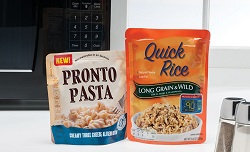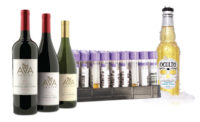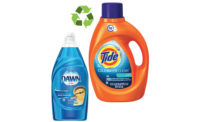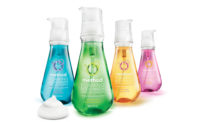Flexible packaging is everywhere and pouch users know of their benefits. They’re easy to hold, carry, store, pour from, snack from and scoop from. Plus, various sizes, handles, spouts and their light weight all lend a welcome hand to today’s busy consumer. While there are already so many innovations in the segment, there may be just as much opportunity.
“While food and beverage account for the largest share of current pouch applications, there is still a lot of room for innovation in these categories across a variety of spectrums including shelf life, the trend towards clear structures where the product is visible, fitments that improve the dispense and use, thus improving the consumer experience,” says Mark Moorhead, director of marketing at Bemis (bemis.com).
So what features improve the consumer experience? Several, actually.
Stand-up and cheer
Stand-up pouches are the epitome of convenience. They store nicely in the pantry, stand up on the counter and allow for easy snacking, scooping, pouring and storing.
John B. Sanfilippo & Son Inc. (JBSS) recently released its stand-up pouches for its popular products including whole nut varieties, sliced almonds, trail mix and snacking nuts that make baking and snacking even more convenient.
JBSS led the way with stand-up pouches with its resealable bag for the Fisher® brand in the recipe nut category in 2012. JBSS has partnered with branding agency Damen Jackson (damenjackson.com) to unveil a stand-up bag in its snack nut line to provide maximum visibility on shelf. The new package features a resealable zipper to promote portability and maintain freshness.
JBSS also partnered with the agency to help update the packaging for Orchard Valley Harvest (OVH), a brand of trail mixes and chocolate covered fruits and nuts. In response to consumer demand for healthier snacks in on-the-go packaging, OVH introduces individually packaged 1.85-ounce grab & go bags and eight-count multi-packs of 1-ounce pouches. The new packaging also features the Non-GMO Project Verified seal and a transparent window into the snack to emphasize the brand’s continued efforts to showcase the transparency of ingredients and processing.
The brand’s new packaging developments have not gone unnoticed; it has received two Certificates of Excellence from the 2016 American Graphic Design Awards on behalf of its Fisher and Orchard Valley Harvest brands. Both awards were in the Flexible Package category. In addition to the innovations to its snack packaging, JBSS is the latest recipient of the prestigious Category Captain Award in the baking ingredient category for its recipe nuts. The award acknowledged Fisher for being the only brand in the recipe nut category to experience growth within 2016.
It’s no wonder the spouted pouch is also gaining in popularity. The benefits are endless and across several markets. According to a recent study released by Technavio (technavio.com), the global spout pouch market is expected to grow at a CAGR of close to 10% during the forecast period (2016-2020).
In the food and beverage industry, not surprising, spouted pouches are most commonly used for packaging baby foods and beverages. The demand for global baby food sales was estimated to be around $30 billion in 2015. Pouches are very big in the children’s beverage segment, but not so much with beverages geared towards adults. The packaging format can certainly hold its own in the segment and there are great success stories with pouches, especially with ready to drink frozen cocktails. But one reason that there is not more is that even though consumers say they like flexible packaging options, their buying habits are not reflecting that trend.
“We see a lot of talk about consumers and brands wanting to be more environmentally friendly and the desire to use less packaging in products. But the consumers, while they may want to make better choices, aren’t making them just yet and continue to purchase products in more traditional packaging formats. There is a difference between what consumers are buying and what they are demanding is available on the shelves. As people become more and more environmentally conscientious, they will be looking for better choices with less overall material and pouches are a better option,” says Andreas Jeppsson, managing director, Ecolean Inc. (ecolean.com).
Innovations in processing will also help further the segment.
“We will also see new processing technologies that will dramatically improve the quality of the product inside along with the speed of filling which will certainly affect product quality and the overall economics of beverages in pouches. This will expand the range of different types of beverages that are offered in a pouch,” says Bemis’ Moorhead.
There is a lot of opportunity in beverage right now and it may just be up to certain groups of consumers, mainly millennials and west coast dwellers, to really make the swap to flexible.
“Millennials and those younger definitely have a greater comfort level with that format for beverages. There are also regional differences in acceptance. West coast consumers are much more comfortable with wine in a box than east coast natives. We think the segment is a prime area for growth, especially given the increasing popularity of online shopping. Look for the evolution of beverage and other liquid pouch structures that are more user-friendly to all generations,” says Amanda Whaley, product manager, Torayfan® Polypropylene Film Division (toraytpa.com).
Recyclability remains an issue
While no one can deny the convenience factor of the pouch, there is ongoing concern over the recyclability of pouches, but change is in motion.
“Recycling is also an issue that presents challenges. When you look at foil pouches – most hot-fill and retort pouches are made with plastic and foil laminate – those pouches are not recyclable and brand owners, in some cases, have shied away from that option,” says Ecolean’s Jeppsson.
Not all pouches are created equal; there are options in the market that solve this issue, without sacrificing strength.
“Ecolean’s packages are made mostly of PE and PP, in addition to small amounts of other polymers. Calcium carbonate is used as a mineral filler (up to 40 percent in white packages) to reduce the amount of plastic used while adding a white color and pack stiffness and stability. This means the packages can be recycled into and used to make other plastic materials all without having to separate the various plastic layers. And since Ecolean packages don’t contain aluminum, we don’t need to sort that layer from the rest either. This helps food producers strengthen corporate social responsibility,” continues Jeppsson.
At Packaging Innovations in March, Mondi Consumer Goods Packaging (mondigroup.com) showcased the EcoFresh pouch – a stand-up pouch solution for fresh produce that is also fully recyclable.
“Combined with our post-harvest science technology (bespoke micro-perforations), pouches offer an excellent light-weight alternative to trays, and provide excellent shelf-life properties. Pouches are convenient, versatile and can offer reclosability, meaning that even after the product has been opened, the atmosphere of the pack can remain at its optimum to help to reduce food waste. However, the traditional combination of materials required to provide the visual shelf presence, strength and barrier properties has meant using a mixture of polymer resins. Until now, that made these pouches nearly impossible to recycle,” says Graeme Smith, Mondi Deeside senior technical manager.
To remedy this, the group sought to create a fully recyclable pouch that featured similar properties of traditional laminate. Made only from polypropylene resins, the packaging can be fully recycled, addressing a big issue in the industry right now.
Materials matter
To reduce spillage, leakage, tears and just about any other mishap that can occur with flexible packaging, the type of material used is a key consideration. Packagers want these films to do it all, so material selection is key as that dictates the package’s strength and recyclability.
“Economically viable, environment-friendly packaging options that don’t sacrifice value and performance are top-of-mind among our customers. Sustainable packaging presents enormous challenges and great opportunity. Look at the changes we’ve seen in the past decade. The goal is to create a cost-effective flexible package that is 100 percent sustainable in its materials and its recyclability. We’re not there yet, but we’re confident the day will come. First, though, costs must come down,” states Toray’s Whaley.
It isn’t just food and beverages that are making their way into more pouches. Personal care products are too, especially soaps and detergents. According to the Technavio report, plastic pouches have gained popularity in packaging of liquids such as liquid bathing soaps, gels, hand soaps, detergents and sanitizers. Rigid packaging options such as bottles, cartons and jars occupy a lot of space on the shelves and can be prone to breakage. Flexible packaging is not without its limitations, as there are chances of spillage of the liquids during dispensing when using a pouch. The manufacturers of pouches have considered spouts to be the solution to this problem.
It’s really the pouch’s benefits and endless possibilities that spur the segment’s growth year after year. That doesn’t mean that there are not still challenges in this popular segment, as well as opportunities. More flexible materials and formats to address recycling and processing issues will help packagers make more informed decisions, and will keep the segment’s growth momentum going strong. To read more about pouches, check out our Global Pouch Forum pre-show coverage on page 36 of the May 2017 print issue of Packaging Strategies.
|
What’s next: ecommerce and flexible packaging So what’s next with flexible packaging? Where will the next big innovation come from? Amanda Whaley, product manager, Torayfan Polypropylene Film Division weighs in. “At Toray we think that the greatest opportunity now for innovation in flexible packaging is e-commerce, which will drive flexible packaging innovation in food, beverage, household, personal care and other market segments. We also think that product protection and branding are two essential packaging functions that will change in the online commerce arena. Shipping goods to the consumer’s door involves a much more complicated distribution cycle in comparison with the traditional model. Now, a mixed array of goods – for example, baby wipes, laundry detergent, nutrition bars and healthful snacks, and protein powders – that would ordinarily fill an in-store shopping cart are bundled into a shipping carton, where they interact with one another. Consumer packaged goods companies are asking: What are the packaging requirements of e-commerce goods? What will be the most cost-effective approach to meeting those requirements without sacrificing oxygen, moisture, aroma barrier performance and the brand image? Should goods that have a colorful brand presence on the store shelf be commoditized in a bulk shipment? Is the product being shipped in the most user-friendly, easy-to-ship format? We are also focused on the activities of meal delivery and meal kit companies, which are creating new markets, distribution channels, and unique packaging requirements. Barrier protection, secure flexible lidding film, and premium appearance and feel are likely to be required in this market.” Toray Plastics (America)’s Barrialox® SBR2 |



 maintains its inherent barrier durability during and after converting and retorting processes. Cooked, ready-to-heat meals packaged in sturdy lightweight pouches made with Barrialox SBR2 are ideal for online shopping orders that are shipped directly to the consumer.
maintains its inherent barrier durability during and after converting and retorting processes. Cooked, ready-to-heat meals packaged in sturdy lightweight pouches made with Barrialox SBR2 are ideal for online shopping orders that are shipped directly to the consumer.


